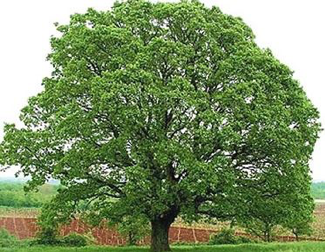Quercus alba: White Oak
 Latin name: Quercus alba
Latin name: Quercus alba
Common name: White Oak
Flowers: Not showy, monoecious, 4-7 lobed calyx enclosing stamen8.
Fruit: ¾ to 1 in. nut, ovoid-oblong8
Height & Width: 50-60’ high and wide8
Type: Deciduous8
Habit: Upright rounded8
Wetland indicator category** :FACU17
Texture: Medium8
Growth rate: Slow to medium8
Light: Full sun8
Moisture: Dry to medium12
Soil*: Deep, moist well-drained soils, pH 5.5 to 6.58
Zones: 3 to 98
Origin: Maine to Florida, west to Minnesota and Texas8
Ecosystem benefits: Provides habitat and forage for wildlife (large nuts)8
Features: Upright rounded structure, brown to red fall color. Ashy gray bark arranged in scales8.
Siting: This tree belongs in areas with a plentiful amount of soil space for the broad root system8. The white oak is not a very urban tree and does not tolerate impervious surfaces well. This tree requires full sun and well-drained soils8.
Care: Plant crown at soil level18. At planting, water the roots and surrounding area slowly and deeply. Keep soil moist until plant is established, then apply enough water to thoroughly moisten the root zone when the soil is dry or during drought. Modify water recommendations to reflect site drainage and rainfall. Apply 3” of mulch over the planted area. Do not allow mulch to touch the plant stems18. Transplant balled and burlapped when the tree is young, plant in a deep, moist, well-drained, acidic soil8.
Pests: Anthracnose, bacterial leaf scorch caused by Xyella fastidiosa, gypsy moth, yellow-necked caterpillar, pin oak sawfly, saddleback caterpillar, oak skeletonizer, Asiatic oak weevil, two-lined chestnut borer, flatheaded borer, leaf miner, oak lace bug and oak mite8.
This plant does not appear on the following invasive plant lists on (3/2/19):
- USDA SC Invasive Plant Species Web site at http://www.invasivespeciesinfo.gov/plants/main.shtml
Author: Jonathan Jones
Image source: https://www.google.com/url?sa=i&rct=j&q=&esrc=s&source=images&cd=&cad=rja&uact=8&ved=2ahUKEwjCqb6gxPHgAhWGPN8KHdsjCxIQjRx6BAgBEAU&url=http%3A%2F%2Fcommunity.homedepot.com%2Fhowto%2FDiscussionDetail%2FWhite-Oak-Quercus-alba-906500000000LIN&psig=AOvVaw1iXmkgK2yaCh-DWnQQAs0O&ust=1552099699662928
Sources :
- Armitage, A. (2001). Armitage’s manual of annuals, biennials, and half-hardy perennials. Portland, OR: Timber Press.
- Armitage, A. (2006). Armitage’s native plants for North American gardens. Portland, Oregon: Timber Press.
- Armitage, A. (2008). Herbaceous perennial plants: A treatise on their identification, culture, and garden attributes. Athens, GA: University of Geogia.
- Clemson Cooperative Extension Home and Garden Information Center.(2011). Flowers fact sheets. Retrieved from https://hgic.clemson.edu/category/flowers/
- Clemson Cooperative Extension Home and Garden Information Center.(2011). Groundcovers & vines fact sheets. Retrieved from https://hgic.clemson.edu/category/groundcovers/
- Clemson Cooperative Extension Home and Garden Information Center.(2011). Trees. Retrieved from https://hgic.clemson.edu/category/trees/
- Clemson Cooperative Extension Home and Garden Information Center.(2011). Shrubs. Retrieved from https://hgic.clemson.edu/category/shrubs/
- Dirr, M. A. (2009). Manual of woody landscape plants. Champaign, IL: Stipes Publishing.
- Gilman, E. F. (1997). Trees for urban and suburban landscapes. Albany, NY: Delmar Publishers.
- Lady Bird Johnson Wildflower Center University of Texas at Austin. (2012). Native plant information network. Retrieved from http://www.wildflower.org/explore/
- McMillan, P., Plant taxonomist Clemson University, personal communication.
- Missouri Botanical Garden Kemper Center for Home Gardening. Plant finder. Retrieved from http://www.mobot.org/gardeninghelp/plantfinder/Alpha.asp
- North Carolina State University (2005). Plant fact sheets. Retrieved from http://www.ces.ncsu.edu/depts/hort/consumer/factsheets/index.html
- Strother, E. V., Ham, D. L., Gilland, L. (2003) Urban tree species guide: Choosing the right tree for the right place. Columbia, SC: South Carolina Forestry Commission.
- University of Florida, IFAS Extension. (2011). Southern trees fact sheet. Retrieved from http://edis.ifas.ufl.edu/department_envhort-trees
- USDA. Plant profile. (n/d).Retrieved from http://plants.usda.gov/java/
- USDA. Plant wetland indicator status. (n/d). Retrieved from http://plants.usda.gov/wetland.html
- Vincent, E., Environmental horticulturist Clemson University, personal communication.
- Clemson Extension. Carolina Yards Plant Database. Retrieved from https://www.clemson.edu/extension/carolinayards/plant-database/index.html
*Soil pH is determined using a professional soil test. Contact your Clemson University County Extension service for assistance www.clemson.edu/extension/. Click on “local offices”.
**2012 Plant Wetland Indicator categories (quantitative derived) http://plants.usda.gov/wetinfo.html
| Indicator Code | Indicator Status | Comment |
|---|---|---|
| OBL | Obligate Wetland | Almost always is a hydrophyte, rarely in uplands |
| FACW | Facultative Wetland | Usually is a hydrophyte but occasionally found in uplands |
| FAC | Facultative | Commonly occurs as either a hydrophyte or non-hydrophyte |
| FACU | Facultative Upland | Occasionally is a hydrophyte but usually occurs in uplands |
| UPL | Obligate Upland | Rarely is a hydrophyte, almost always in uplands |
